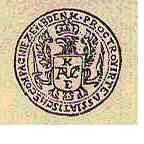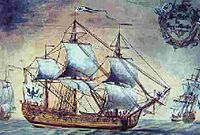Emder East Asian trading company
The Emden East Asian Trading Company was a trading company from the 18th century based in the East Frisian city of Emden , founded by Frederick the Great in 1751 under the official name "Royal Prussian Asian Company in Emden to Canton and China" and dissolved in 1765.
prehistory
Economic thinking in Europe in the 18th century was dominated by mercantilism . As one of the most important consequences of this teaching, every country strove to have goods imported from Asia through a national trading company. In a mercantilist sense, a nation was weakened when it bought goods such as tobacco, spices, and tea from a large foreign company. Too much domestic capital would flow abroad. To prevent this, it seemed necessary for every state to have its own trading company. Kings and merchants in countries like Denmark , Sweden and Flanders , referring to these mercantilist theories, demanded the establishment of Indian or Asian trading companies. Older companies in Europe such as the British East India Company or the Dutch East India Company sought to protect their monopolies in India trade by trying to harm new competitors. In 1737 the successful Flemish Generale Compagnie was dissolved through political intrigues by the sea powers.
The Kingdom of Prussia , which developed into a major European power during this time, was ruled by King Friedrich II from 1740 . His economic policy is also considered to be inspired by mercantilism. He had the Prussian-Asiatic Company founded.
Formation and share issue
After East Frisia was annexed to Prussia in 1744 , the Prussian economy had access to the North Sea and thus to overseas trade with the port of Emden . On August 1, 1750, Frederick II gave the Amsterdam merchant Heinrich Thomas Stuart the royal privilege (Oktroi), which allowed him to trade between Emden and China with ships under the Prussian flag until 1770 . Trade with China would be worthwhile, as the older East Indian trading companies had failed to establish a monopoly in the powerful Chinese Empire. The Chinese traders could also deliver goods that were very popular in Europe: tea, china and silk. The European ships were only allowed to anchor in the port of the southern Chinese city of Canton .
On May 24, 1751, the Prussian king came to the founding meeting of the trading company Königlich Preußische Asiatische Compagnie (KPAC) based in Emden, which was to specialize in trade with India and China and whose capital was mainly provided by Dutch and French shareholders. The interest in the shares was great and so 482 shares of 500 thaler each (= 241,000 thaler) were subscribed on the day of its foundation. One of the major shareholders was the banking and trading company Splitgerber & Daum in Berlin. However, 50% of the capital was owned by the Netherlands. The largest participant was the influential banker Emmanuel van Ertborn from Antwerp with 705 shares. Like many other Flemish businessmen, Van Ertborn was looking for new business models after the dissolution of the Flemish East India Company.
On May 24, 1751, the king granted a privilege to a group of Prussian, Flemish and Dutch donors. These major shareholders were represented in Emden by two managing directors: Mayor Jacob de Pottere and Kommerzienrat Johann Gottfried Teegel. The new trading company got the monopoly for trade between China and Prussia. The privilege also made it possible to conclude treaties with foreign Asian princes in the name of King Friedrich. The company ships were allowed to let the royal pavilion - the Prussian flag with the eagle, sword and scepter - fly from the masts.
The Royal Prussian Asian Compagnie (KPAC) already had a capital of 861,000 thalers in 1752, distributed over 1,722 shares.
The company's aim was to import overseas goods such as tea , china , silk , spices , cotton and medicines . In order to further promote the project, the king declared the port of Emden a free port on November 15, 1751 , so all goods were exempt from customs duties.
From Emden to China
The first voyage of a company ship, the “ King of Prussia ”, was a complete success. It led via Java to Canton , from where the ship returned to Emden in July 1753. The return load consisted of tea, raw silk, porcelain and various medicaments and was auctioned in Emden in August 1753 in the presence of Elector Clemens August of Cologne .
On September 9, 1752, the second company ship, the frigate “ Burg von Emden ”, equipped with twenty six-pounder, six three-pounder and twelve half-pounder cannons, started the long journey to China. Among the crew of 118 was Jean François Michel from Mechelen ( Flanders ), assistant businessman and agent of the major shareholder Emmanuel van Ertborn. During the trip from Emden to China he wrote a travel report: Journal de voiage à la Chine et courte description de la ville d'Embden . Thanks to the precise entries in the journal, we are able to reconstruct the trip to China day by day.
The "Castle of Emden" anchored on May 30, 1753 in the mouth of the Pearl River, four miles from the city of Canton in China. At the beginning of December 1753 the ship sailed again and arrived happily on the roadstead at Emden on May 28, 1754. 575,214 pounds of precious Chinese tea were loaded in their rooms, but zinc, silk and china were also brought along. The freight was auctioned off in Emden at a great profit.
A total of two other ships left Emden for China in the years after 1753, and only one of them suffered slight damage when it ran aground near Borkum on the return voyage . Given the many dangers in overseas trade at the time, this was a remarkable achievement.
The beginning of the Seven Years' War in 1756 brought about the decline of the trading company. When French troops marched into East Friesland , the director of the trading company, Johann Gottfried Teegel, fled to Delfzijl in the Netherlands with the "King of Prussia" and the company's liquid capital . Two more ships were dismantled in Emden, while the company's youngest ship, the "Prinz Ferdinand", came from Canton to the English port of Plymouth , where the ship and cargo were sold.
After the Seven Years' War, Frederick II dissolved the company in 1765. In addition to their contribution capital and 500 thalers, the shareholders received an annual dividend of two percent.
Trips of the individual company ships
- "King of Prussia": Bought for 70,000 thalers in London in autumn 1751, her journey with 132 men led from Emden via Java to Canton on February 15, 1752, and back on July 6, 1753 in Emden. 20 seafarers died on the voyage or in canton from accidents or illness.
- "Burg von Emden": Bought for 45,000 thalers in London in autumn 1751, started from Emden to Canton on October 4, 1752, and returned to Emden on May 28, 1754.
- “ Prince of Prussia ”: Bought in Amsterdam in December 1753, her journey with 186 men leads from Emden to Canton on December 31, 1753, stranded near Borkum in July 1755, and back in Emden on July 10, 1755. It is assumed that this is the journey on which the so-called “Prussian service” (a table service made as a Chinese custom- made porcelain with the royal Prussian national coat of arms) came from Canton to Europe.
- "King of Prussia" April 1754 from Emden to Canton, in June 1756 back in Emden.
- "Castle of Emden": December 1754 from Emden to Canton, in June 1756 back in Emden.
- "Prince Ferdinand": Bought in 1754, the ship travels from Emden to Canton in 1755, on September 11, 1757 in Plymouth , England.
literature
- Bernd Eberstein : Prussia and China. A story of difficult relationships . Duncker & Humblot, Berlin 2007, ISBN 978-3-428-12654-5 .
- Ostfriesisches Landesmuseum Emden : Made in China: porcelain and tea culture in the northwest . Isensee Verlag, Oldenburg / Emden 2015, ISBN 978-3-7308-1160-3 .
- Sook Hi Park : Chinese made-to-order porcelain from the East Asian trading company in Emden . Verlag der Ostfriesische Landschaft, Aurich 1973, ( treatises and lectures on the history of Ostfriesland 55, ISSN 0724-9772 - also: Münster Westf., Univ., Diss., 1971; there also references to the older literature).
- Contributions to the history of the "Asiatic-Chinese trading society" in Emden 1750–1755, and King Friedrich II's participation in the same . In: Hansa. Zeitschrift für Seewesen 21, 1884, pp. 57-60, ISSN 0017-7504 .
- Jean François Michel : Journal de voiage à la Chine et courte description de la ville d'Embden . 1755 (Published by Henri Cordier : La Compagnie Prussienne d'Embden au XVIII e siècle. In: T'Oung Pao ou Archives concernant l'histoire, les langues, la géographie et l'ethnographie de l'Asie orientale 19 (1920) p 127-243 ( online at Gallica )).
- Viktor Ring : Asian trading companies of Frederick the Great. A contribution to the history of Prussian maritime trade and stock trading . Heymann, Berlin 1890, archive.org
- Dennis de Graaf : From Emden to China . In: Ostfriesland Magazin July 1998, ISSN 1435-6376 .


